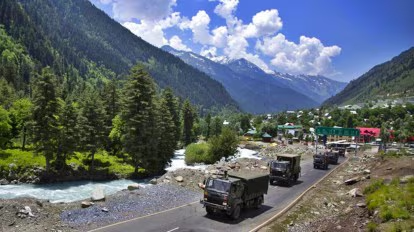After more than four years of heightened tensions along the Line of Actual Control (LAC) in eastern Ladakh, India and China have begun a phased disengagement of troops. This disengagement marks a notable shift following extensive diplomatic talks and high-level meetings, including a recent dialogue between Indian Prime Minister Narendra Modi and Chinese President Xi Jinping in Kazan. Officials from both countries have confirmed that the process is proceeding “smoothly,” with initial movements in the Depsang Plains and Demchok sectors. However, experts caution that this step, while promising, is only a start in a complex journey towards a stable and peaceful border.
Background of the India-China Border Tensions Along the LAC
The border dispute along the LAC has its origins in historical disagreements and competing territorial claims. The conflict flared up significantly in 2020, leading to the deployment of tens of thousands of troops from both India and China in the Ladakh region. Tensions reached a peak with the violent Galwan Valley clash, which caused casualties on both sides and marked the deadliest confrontation in over four decades. Since then, multiple rounds of talks have been held at military, diplomatic, and political levels to resolve the standoff. These talks, though occasionally yielding partial solutions, have often stalled, leading to a prolonged state of military alert on both sides.
The Recent Disengagement in Depsang Plains and Demchok: Key Details
On October 24, 2024, the Indian Army confirmed the initiation of the disengagement process in the sensitive areas of Depsang Plains and Demchok. Soon after, China’s Ministry of Foreign Affairs also affirmed that “Chinese and Indian frontier troops are engaged in relevant work, which is going smoothly.” This development comes as a result of continuous diplomatic efforts and represents a crucial phase in de-escalating the standoff. Disengagement in these areas involves both Indian and Chinese troops gradually pulling back from forward positions, creating buffer zones, and reducing the risk of accidental clashes.
Statements from Indian and Chinese Leaders on Disengagement
In the wake of the disengagement, senior officials from both India and China have voiced cautious optimism. India’s External Affairs Minister S. Jaishankar stated that while the disengagement is an essential step forward, it represents only the beginning of a longer, multi-phase process required to restore stability and trust along the LAC. The Chinese Ministry of Foreign Affairs echoed this sentiment, with a spokesperson stating that China is committed to working with India in maintaining peace and stability along the border. Both sides have underscored the importance of adherence to agreed-upon protocols, and stressed the need for sustained communication.
Diplomacy at Work: The Modi-Xi Meeting and Its Impact on the Disengagement Process
The recent disengagement can be traced back to the high-profile Modi-Xi meeting during the BRICS summit in Kazan, where the two leaders discussed the border situation at length. The meeting was instrumental in reinforcing a mutual commitment to disengagement and border stability. By engaging in direct dialogue, both sides established a framework for resolving some of the issues along the LAC, a process that now sees its first fruits with the withdrawal at Depsang and Demchok. The Modi-Xi engagement underscores the significance of leader-to-leader diplomacy in resolving sensitive international issues.
The Path Ahead: Challenges in Achieving Lasting Stability
Despite the progress made, the disengagement in Ladakh is only one component of the larger India-China border issue. The LAC spans over 3,440 kilometers, and tensions also exist in regions such as Arunachal Pradesh. India remains firm in its demand for a return to pre-2020 patrolling rights and the re-establishment of the status quo. On the other hand, China has shown a strong interest in asserting control over its claimed areas, which has led to ongoing infrastructure development on both sides of the border. This reality means that, while the recent disengagement is positive, continuous vigilance and clear protocols are necessary to prevent future conflicts.
Implications for India-China Relations
The disengagement in Ladakh has wider implications for India-China relations, which have been strained due to geopolitical competition, trade disputes, and divergent interests in regional security. The current pullback of troops could signal a shift towards a more collaborative approach, but India’s defense strategy is likely to remain cautious. New Delhi has also been strengthening alliances with other countries in the Indo-Pacific, reinforcing a multi-pronged approach to security. For India, maintaining a balanced yet assertive stance in its relations with China will be critical to ensuring both sovereignty and stability in the region.
A Positive Move Toward Peace, with More to Follow
The initiation of the disengagement process in Ladakh’s Depsang Plains and Demchok is a step in the right direction for India-China relations, reducing the immediate risk of confrontation. However, the journey toward a truly peaceful and stable border will likely require ongoing diplomatic and military cooperation. As both nations proceed with the disengagement, the world will be watching closely to see how India and China manage this fragile phase in their complex relationship. For now, this progress represents a glimmer of hope amid a protracted and challenging conflict.


Leave a Reply